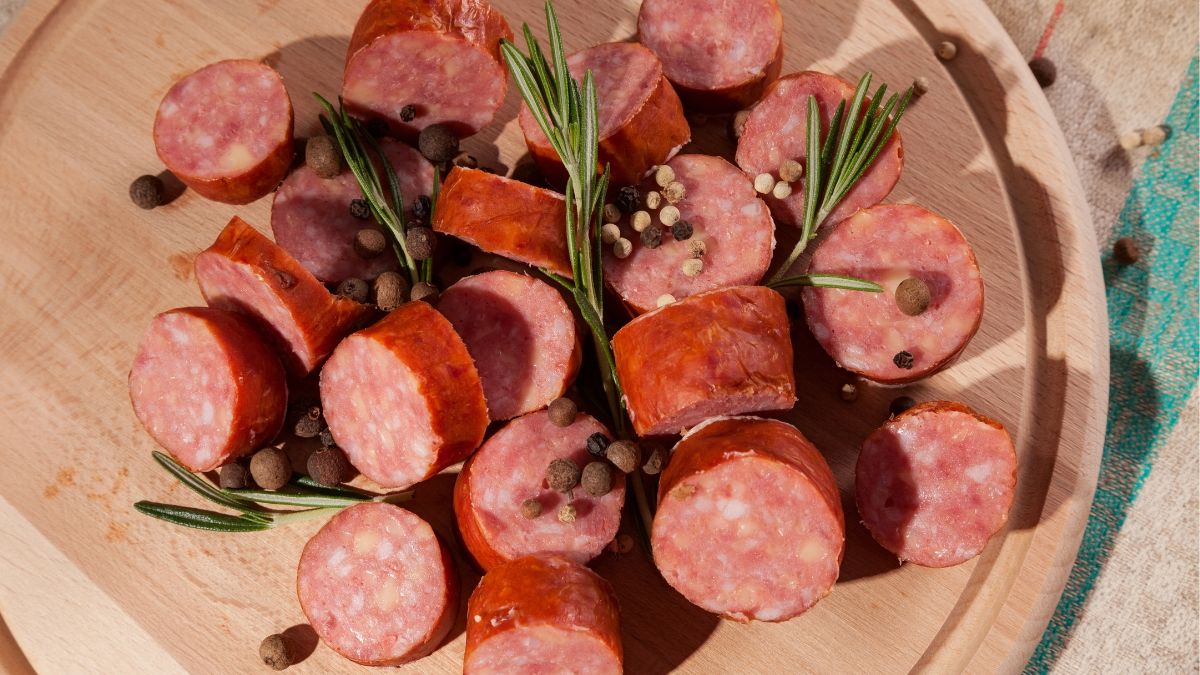Can You Eat Sausage Casing? Yes and No – Find Out Why!

All sausages have casings, yet not all people eat them. You must have noticed that some sausages come “naked” and some don’t. I prefer to eat the sausage with the casing, but sometimes that’s not what you should do. So, can you eat sausage casing?
There are edible and inedible sausage casings. The edible casings are made from natural materials, while the inedible ones are made from synthetic materials.
Although eating an inedible sausage casing won’t cause any severe harm, it isn’t recommendable that you eat an inedible casing. As a huge sausage fan, I’ve allowed my greed to take the better of me, so I learned the hard way that not all sausage casings are the same. Generally, eating the sausage casings won’t do you any severe harm, but it may cause you some digestion difficulties. In this article, I will share my wisdom with you so that next time you enjoy your juicy sausages to the fullest.
Which Sausage Casings Are Edible and Which Are Not?
The safest way to know if the sausage casings are edible or not, read the label and see. It will give you the most accurate answer. Still, it couldn’t hurt to know some general stuff about them.
The most general division of sausage casings is in two groups; those made with natural materials and those made with artificial materials. The natural ones are safe to eat, and the artificially made ones — not so much.
Although no one casing will seriously damage your digestive tract, there are those you shouldn’t eat, especially if you have a sensitive stomach.
Generally, there are four main types: natural, collagen, cellulose, and synthetic. You can probably already guess which are edible and which are not, but let’s get into it anyway.
Natural casings come from animal sources and are typically made from the intestines of animals. The most common natural sausage casings come from pigs, sheep, and cows. As unpleasant as this may sound, these are the best and the safest.
These are flexible, degradable, and provide a traditional texture to sausages. A natural casing is translucent and soft; you can’t notice it when the sausage is cooked. Raw sausage with a natural casing is tender and soft, and they are used mainly by individual sausage-makers rather than on an industrial scale.
Collagen casings are artificial ones made from the connective tissues of animals. You can think of them as the industrial-scale version made from intestines. They are widely used in the sausage-making industry because they have consistent sizes and are easy to find and use. They are often used for processed sausages like hot dogs and snack sticks but have wide application in cured sausage making.
Cellulose casings are artificial casings, but come from plant-based materials. As such, they are not edible, and their primary use is to hold the shape of the sausage. Although they won’t harm you, it isn’t recommended that you eat them, especially if you often have cellulose-encased sausages.
Since it sticks to the meat when cooked, you should remove it before cooking the sausage. It’s clearly visible, so you’ll know if your sausage is encased in it. These can vary in thickness, so there may be gentler and tougher varieties.
Cellulose casings are widely used for sausages, so you can find them on smoked, fresh, or processed sausages.
Synthetic casings are used on an industrial scale for speed-production of sausages. They are certainly not edible and must be removed before eating the sausage. Synthetic ones are made from polymers, such as plastic or nylon.
You can find them on hot dogs, salami, or fresh or smoked sausages. They are widely used, and if you buy sausages from a supermarket, they will likely be encased in this.
Why Some People Remove Sausage Casing?

If the casing is edible, removing or leaving it is purely a personal preference. Some people like them, and some don’t. The ones made with intestines are undetectable, and removing them is unnecessary.
The collagen casing can be bothersome, as it sticks to the sausage and makes it harder to bite. Also, it may become crispy due to the cooking, and some people just don’t want to bother and peel it off afterward.
Still, some aren’t edible, so people remove them because they shouldn’t eat them. Some hold the sausage tight, which makes eating a challenging experience.
I prefer my sausages with casings, if it’s edible, of course. So, it all boils down to how you like your sausages. If the casing is edible, have them as you like them best, but if it isn’t, you have to remove it, no matter whether you prefer the sausages with or without it.
Inedible casings are rarely a cause for concern if you eat them, but if they become a regular occurrence, they may cause indigestion or stomach pain. So, don’t worry if you don’t remove an inedible sausage casing once or twice.
Also, there are salami sausages in inedible casings. You absolutely have to remove these casings, but I think that you already do this.
How to Remove the Casing?
The sausage casings are very easy to remove. The thicker ones are simpler to remove because they are easier to separate from the meat. The thinner ones, usually made from intestines, are harder to remove, but there’s also no need to remove them.
Another thing you should know about the intestine casings is that the sausage underneath is often fragile, and if you remove it, it may fall apart, especially if you pan-fry or grill it.
Otherwise, to remove the sausage casing, just score the casing without cutting into it and remove it by opening it. I like to score the casing along the sausage so it is easier to open. You can also try to push the sausage out of the casing, which also works, but the sausage needs to be very compact, and the casing needs to be a little thicker.
If you remove the casing from smoked sausage, simply peel it off. Smoked sausages are more robust and resilient, so they are not likely to fall apart when you take the casing off.
Can You Cook Sausage Without Casing?
Yes, you can definitely cook a sausage without the casing, but this would depend mainly on the type of sausage. For example, if you remove the casing from a fresh soft sausage, it is likely to fall apart or stick when cooking.
If you cook processed sausages, such as hot dogs, you can easily cook them without the casing. If you cook smoked sausages, removing the casing will cause you no trouble cooking them.
When I need to remove it, I check the sausage to see if and how I can cook it. If the sausage is robust and compact, I remove the casing and cook it any way I like, but if the sausage is soft and likely to lose its shape, I either don’t remove the casing or remove it and oven-bake it.
If you intend to cut your sausages and cook them in pieces, it makes no difference whether or not you remove it.
What Does Sausage Casing Taste Like?

Sausage casings are flavorless, and their purpose is not to add or change the flavor of the sausage but to keep its shape. However, they can change the texture, making the sausage crispier or a little harder to bite.
I like my sausages with the casing because I like their crispiness, but they make no difference in the taste.
What Is Chicken Sausage Casing Made Of?
Like all sausage casings, chicken sausage casings can be made of intestines, collagen, cellulose, or plastic. Still, most frequently, chicken sausages are encased in natural casings, i.e., casings made of intestines.
Chicken sausages are often soft and very fragile, so the casing needs to be edible so you don’t have to remove it, causing the sausage to fall apart. Therefore you will most frequently find chicken sausages in natural casings. That doesn’t mean they are never encased in artificial casings, but intestines are often used for this purpose.
